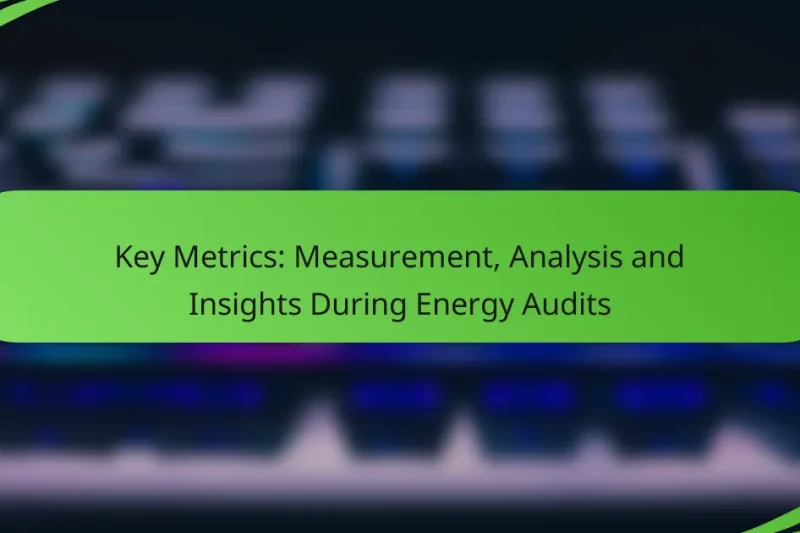Lighting assessment plays a crucial role in energy audits by identifying inefficiencies and optimizing lighting systems, … Lighting Assessment: Importance, Techniques and Benefits in Energy AuditsRead more
Key Components of Green Building Energy Audits
Green building energy audits are essential for assessing a building’s energy performance and uncovering opportunities for enhanced efficiency. By focusing on components such as energy consumption analysis, HVAC evaluations, and renewable energy integration, these audits provide valuable insights that help property owners reduce energy waste and costs.
Renewable Energy Options: Evaluation, Benefits and Integration in Energy Audits
Renewable energy options present a viable pathway for businesses in the UK to reduce their carbon … Renewable Energy Options: Evaluation, Benefits and Integration in Energy AuditsRead more
Key Metrics: Measurement, Analysis and Insights During Energy Audits
Key metrics in energy audits play a crucial role in evaluating energy efficiency, cost savings, and … Key Metrics: Measurement, Analysis and Insights During Energy AuditsRead more
Residential Green Building Energy Audits: Essential Tools, Techniques and Standards
Residential green building energy audits are vital for enhancing energy efficiency, lowering utility costs, and increasing … Residential Green Building Energy Audits: Essential Tools, Techniques and StandardsRead more
What are the key components of green building energy audits?
Green building energy audits focus on evaluating a building’s energy performance to identify opportunities for efficiency improvements. The key components include energy consumption analysis, building envelope assessment, HVAC system evaluation, lighting efficiency review, and renewable energy integration.
Energy consumption analysis
Energy consumption analysis involves tracking and assessing the total energy usage of a building over time. This includes evaluating utility bills, identifying peak usage periods, and determining the energy intensity per square meter.
To conduct an effective analysis, consider using energy monitoring systems that provide real-time data. This helps in pinpointing areas where energy waste occurs and in setting benchmarks for improvement.
Building envelope assessment
The building envelope assessment examines the exterior components of a building, including walls, roofs, windows, and doors, to evaluate their insulation and air sealing effectiveness. A well-insulated envelope minimizes energy loss and enhances comfort.
Common techniques for this assessment include thermal imaging and blower door tests, which help identify leaks and areas needing improvement. Upgrading insulation or sealing gaps can lead to significant energy savings.
HVAC system evaluation
The HVAC system evaluation focuses on the heating, ventilation, and air conditioning systems to ensure they operate efficiently. This includes checking for proper sizing, maintenance, and energy efficiency ratings of the equipment.
Consider implementing regular maintenance schedules and upgrading to high-efficiency models, which can reduce energy consumption by a substantial percentage. Additionally, programmable thermostats can optimize energy use based on occupancy patterns.
Lighting efficiency review
The lighting efficiency review assesses the types of lighting used and their energy consumption. It involves evaluating the effectiveness of current fixtures and considering upgrades to energy-efficient options like LED lighting.
Implementing smart lighting controls, such as motion sensors and timers, can further enhance efficiency by reducing energy use in unoccupied spaces. This can lead to noticeable reductions in electricity costs.
Renewable energy integration
Renewable energy integration focuses on incorporating sustainable energy sources, such as solar panels or wind turbines, into the building’s energy system. This can significantly reduce reliance on non-renewable energy sources and lower utility costs.
When considering renewable options, assess the building’s location, available incentives, and potential return on investment. Many regions offer tax credits or rebates for renewable energy installations, making them more financially viable.
How do energy audits improve building efficiency?
Energy audits enhance building efficiency by identifying inefficiencies and recommending improvements. These assessments provide a comprehensive overview of energy consumption patterns, enabling property owners to make informed decisions that lead to reduced energy waste and lower costs.
Identify energy waste
Identifying energy waste is a crucial step in energy audits. This process involves analyzing energy consumption data to pinpoint areas where energy is being used inefficiently, such as outdated heating systems, poor insulation, or inefficient lighting. Common methods include using energy monitoring tools and conducting thermal imaging inspections.
For example, a building may discover that its HVAC system is operating at a fraction of its efficiency due to neglected maintenance or improper settings. Addressing these issues can lead to significant energy savings.
Optimize energy usage
Optimizing energy usage focuses on implementing strategies that enhance the efficiency of energy consumption. This may involve upgrading to energy-efficient appliances, utilizing smart building technologies, or adjusting operational schedules to align with peak energy rates.
For instance, installing programmable thermostats can help manage heating and cooling more effectively, reducing energy use during unoccupied hours. Such optimizations not only lower energy bills but also contribute to a more sustainable building operation.
Reduce operational costs
Reducing operational costs is a primary benefit of conducting energy audits. By identifying and addressing inefficiencies, building owners can significantly lower their utility expenses. This reduction often translates to savings of 10-30% on energy bills, depending on the building’s initial condition and the improvements made.
Additionally, investing in energy-efficient upgrades may qualify property owners for tax incentives or rebates, further enhancing financial benefits. Regular audits can help maintain these savings over time, ensuring that buildings remain cost-effective and environmentally friendly.
What tools are used in green building energy audits?
Green building energy audits utilize a variety of specialized tools to assess energy efficiency and identify areas for improvement. Key tools include infrared thermography cameras, blower door tests, and energy modeling software, each serving distinct purposes in the audit process.
Infrared thermography cameras
Infrared thermography cameras detect heat loss in buildings by capturing thermal images. These images reveal temperature variations, helping auditors identify insulation deficiencies, air leaks, and moisture issues. When using these cameras, it is essential to conduct the audit under consistent temperature conditions for accurate results.
For effective use, ensure the building is at a stable temperature, ideally with a significant difference between indoor and outdoor temperatures. This method can quickly highlight problem areas, allowing for targeted remediation efforts.
Blower door tests
Blower door tests measure the airtightness of a building by creating a pressure difference between the inside and outside. This process helps identify air leaks that contribute to energy loss. A fan is mounted in an exterior doorway, and as it depressurizes the building, the amount of air entering through leaks is quantified.
To achieve reliable results, conduct the test when the building is unoccupied and all windows and doors are closed. This test is crucial for understanding how well a building retains conditioned air, which directly impacts energy efficiency.
Energy modeling software
Energy modeling software simulates a building’s energy performance based on design specifications and operational data. This tool allows auditors to predict energy consumption, evaluate different design scenarios, and assess the potential impact of energy-saving measures. It is particularly useful for new constructions or major renovations.
When using energy modeling software, input accurate data regarding building materials, occupancy patterns, and local climate conditions. This ensures the simulation reflects real-world performance, guiding effective decision-making for energy efficiency improvements.
What are the benefits of conducting energy audits in urban areas?
Conducting energy audits in urban areas offers numerous advantages, including reduced energy consumption and improved sustainability. These audits help identify inefficiencies, leading to cost savings and enhanced environmental performance.
Lower carbon footprint
Energy audits play a crucial role in lowering the carbon footprint of buildings in urban settings. By pinpointing areas of energy waste, such as outdated HVAC systems or poor insulation, property owners can implement targeted upgrades that significantly reduce greenhouse gas emissions.
For example, upgrading to energy-efficient appliances and improving insulation can cut energy use by 20-30%. This not only benefits the environment but also aligns with many cities’ sustainability goals and regulations.
Enhanced occupant comfort
Improving energy efficiency through audits directly enhances occupant comfort in urban buildings. By addressing issues like drafts or uneven heating, buildings can maintain more consistent temperatures and better indoor air quality.
Implementing recommendations from energy audits, such as sealing leaks or upgrading ventilation systems, can lead to a more pleasant living or working environment, which is essential in densely populated areas where comfort is often compromised.
Increased property value
Conducting energy audits can lead to increased property value in urban areas. Energy-efficient buildings are often more attractive to buyers and tenants, as they promise lower utility bills and a smaller environmental impact.
Investing in energy upgrades can yield a return on investment of 5-15% or more, depending on the local real estate market. Properties that meet or exceed energy efficiency standards are likely to command higher prices and attract environmentally conscious buyers.
What regulations impact green building energy audits?
Green building energy audits are influenced by various regulations that ensure energy efficiency and sustainability. Key regulations include local building codes, state energy policies, and national standards that guide the auditing process and set benchmarks for energy performance.
International Energy Conservation Code (IECC)
The International Energy Conservation Code (IECC) establishes minimum energy efficiency requirements for residential and commercial buildings. It serves as a model code that states can adopt, ensuring that buildings meet specific energy performance standards.
When conducting energy audits, it is crucial to reference the latest version of the IECC, as it is updated periodically to reflect advancements in technology and energy efficiency practices. Compliance with these standards can lead to significant energy savings and reduced operational costs.
For example, the IECC mandates specific insulation levels, window performance, and HVAC efficiency ratings. Auditors should evaluate these components during assessments to ensure compliance and identify opportunities for improvement.



